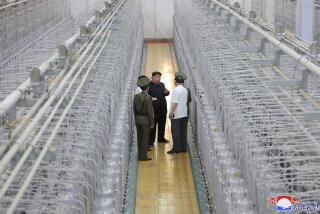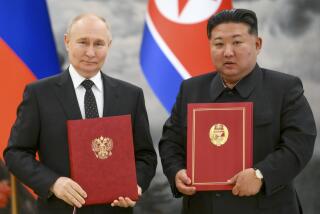Pyongyang’s ‘to do’ list
- Share via
Negotiations with North Korea are not for those who require instant gratification. Assistant Secretary of State Christopher Hill, the ever-patient chief U.S. negotiator, has compared it to “watching turtles race.” Even as there is progress to celebrate, the list of vital issues still to be resolved with Pyongyang gets longer.
But what has actually been accomplished through the six-party talks? A year ago, North Korea had a factory churning out weapons-grade plutonium for nuclear warheads. The Yongbyon plant was shut down in July, and this time it hasn’t been mothballed. It’s being disabled. In three highly symbolic gestures, Pyongyang made a formal declaration of its nuclear activities, the United States promised to remove North Korea from its list of state sponsors of terrorism, and the North Koreans actually blew up the cooling tower of the plant with international TV cameras running. With most other countries, pulling off such a simple diplomatic transaction would be unremarkable. Given the bitter U.S. history with North Korea, however, this is nothing short of historic.
At the same time, North Korea is still very far from nuclear disarmament. It hasn’t made a deal to hand over its plutonium stockpiles or whatever warheads it has fashioned. And it is already evident that the 60-page declaration it made last month is not a full and complete accounting of all of its nuclear activities. For starters, there is the discomfiting discovery that some of the documents it handed over were themselves contaminated with highly enriched uranium -- though North Korea has long denied U.S. allegations that it has a secret uranium enrichment program, and there have been increasing doubts about the quality of the U.S. intelligence that led to that allegation.
This bombshell raises new questions. Is the uranium merely enriched, or is it weapons-grade? (U.S. officials aren’t saying.) Were the documents contaminated inside a North Korean uranium enrichment facility? Or could the papers have been contaminated by exposure to documents or material from the network of Pakistani nuclear black-marketeer A.Q. Khan, with whom Pyongyang is known to have had dealings? The North Koreans could be telling the truth in saying that they do not (now) have a uranium weapons program -- but the burden is on them to prove it to the International Atomic Energy Agency. And what exactly was North Korea’s role in helping Syria build a suspected nuclear facility that looked exactly like Yongbyon from the air before it was bombed by Israel in September?
North Korea had better tell all now, while the Bush administration is eager to build its legacy. The next U.S. president will not have the political luxury of watching turtles race.
More to Read
Sign up for Essential California
The most important California stories and recommendations in your inbox every morning.
You may occasionally receive promotional content from the Los Angeles Times.










